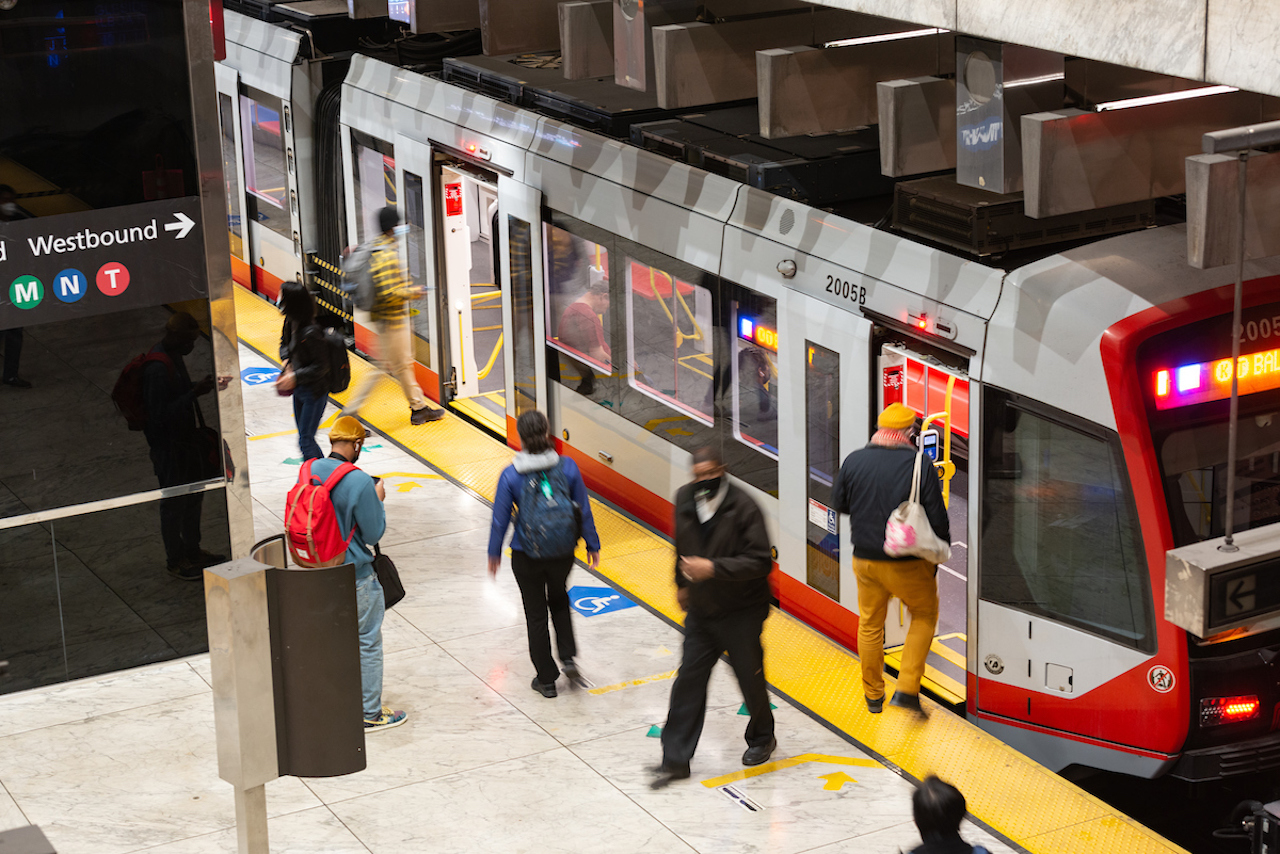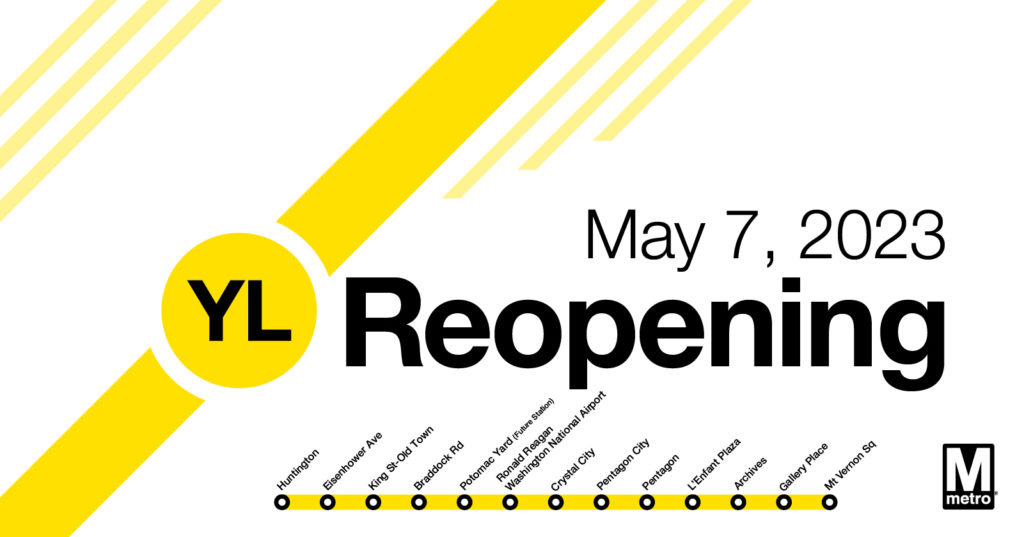
Transit Briefs: SFMTA, WMATA, TTC, Caltrain
Written by Carolina Worrell, Senior Editor
People in Muni Metro Embarcadero Station with LRV | March 8, 2022
The San Francisco Municipal Transportation Agency (SFMTA) announces that rider satisfaction is the highest it has been in 10 years. Also, Washington Metropolitan Area Transit Authority’s (WMATA) Yellow Line train service resumes; the Toronto Transit Commission’s 504A King streetcar resumes service; and Caltrain awards construction contract for Mountain View Transit Center Grade Separation and Access Project.
SFMTA
Based on a Rider Survey recently conducted by the SFMTA, 66% of Muni riders rate services as good or excellent—a 9% increase from 2021.
According to SFMTA, which also conducted a broader Community Survey, real-time data from the agency’s partners at Transit App in their North American Transit Rider Happiness Benchmarking Survey provides additional details about community feedback.
Among the findings:
- The City Survey shows Muni’s rating at its highest level since 2013.
- Transit App’s survey shows Muni in the Top 5 North American cities when it comes to ranking riders most likely to recommend their public transit system to a friend.
- Transit App also shows that Muni riders give the agency’s drivers the highest overall approval rating across North America.
- Finally, the Community Survey showcases that agency’s riders have a much higher approval rating for the SFMTA than non-riders.
Highlights from SFMTA’s Community Survey include:
- 71% of riders approve of the SFMTA compared to 48% of non-riders.
- 66% of riders rate Muni service as excellent/good compared to 48% of non-riders.
- By 9 points, regular riders also consider Muni safer than non-riders.
WMATA
As of Sunday, May 7, WMATA’s Yellow Line service has resumed across the Potamic River, following an eight-month, on-time and anticipated to be under budget rehabilitation project to repair the deteriorating 1970s tunnel and bridge.
According to WMATA, the reopening, announced last month, will provide “a faster, more direct connection for customers between Virginia and downtown DC, including travel to/from Ronald Reagan Washington National Airport.”

Yellow Line trains will initially operate every eight minutes on weekdays from 6 a.m. until 9 p.m. for the first month between Huntington and Mount Vernon Square, and every 12 minutes all other times and on weekends—a 60% increase in train service than before the closure last fall. In June, service will improve to eight minutes all day, seven days a week.
The Yellow Line has been closed since September to allow for major construction on the tunnel and bridge. The $384 million project included replacing more than 1,000 individual steel plates held together by more than 12,000 bolts and mitigating water intrusion in the tunnel.
“This was incredibly difficult work, with construction crews working around the clock to reconstruct the steel lined tunnel and repair the bridge. The tunnel today is like new again and built to last for decades to come,” said WMATA General Manager and Chief Executive Officer Randy Clarke. “Thank you to our customers who took shuttle buses and endured longer commutes so that we could get this critical safety work completed.”
On the 3,000-foot bridge spanning the Potomac River, much of the repairs occurred beneath the bridge. The work required barges and heavy-duty equipment to lift the bridge from the steel girders to remove and replace 88 bearings on the bridge. The project also upgraded the fire suppression system on the bridge and removed and replaced miles of critical communications cables used by multiple regional partners.
“We appreciate the work of our WMATA staff, our contractor Kiewit and their subcontractors for their commitment to this project and the coordination of our many regional partners, including the National Park Service to stage equipment and provide access for construction from Hains Point,” said Clarke.
TTC
TTC’s 504A King streetcar resumed service Sunday, May 7, following more than two years of being closed to accommodate major City works on water mains and sewers in the area, as well as streetcar track replacement, extension of a dedicated streetcar right-of-way, enhancements to streetcar stops and improved safety for pedestrians and cyclists.
From January 2021 until May 2023, buses replaced the 504 King between Dundas West Station and Dufferin Street, including the intersection at King St. W., and Roncesvalles Ave.
“I’m glad to see TTC streetcar service returning to King and Roncesvalles after this major and much-needed work. This is another example of the work underway to build up our city and make significant investments in infrastructure,” said Deputy Mayor Jennifer McKelvie. “Thank you to everyone for their patience as we completed these important upgrades.”
“Ensuring the 504 King to and from Dundas West Station resumes in time for summer is a tremendous example of the dedication and commitment of TTC and City staff,” said TTC Chair Jon Burnside. “We know that service disruptions can be frustrating for our customers, and I’m really pleased that we’re able to resume streetcar service. Thank you to the team that went above and beyond to get this done.”
“Following the very complex reconstruction of the King / Queen / Queensway / Roncesvalles intersection, I welcome the return of the 504 streetcar to Roncesvalles Avenue,” said Ward 4 City Councillor, Gord Perks. “The return of one of the busiest surface streetcar routes in North America is very exciting news.”
“I would like to thank the local Roncesvalles community for their support and patience during construction,” said TTC CEO Rick Leary. “Together with our City partners we completely rebuilt the streetcar tracks, re-established and aligned new overhead cables, and tested and commissioned the infrastructure to facilitate the resumption of service for May 7. It’s a welcome
According to TTC, the 501 Queen will continue to short-turn at Queen St. W., and Roncesvalles Ave., as construction continues in the area. 501L Queen buses operate from Queen St. W., and Dufferin St., to Long Branch.
Caltrain
Caltrain on May 4 announced that its Board of Directors voted to award a Construction Manager/General Contractor (CM/GC) contract for the Mountain View Transit Center Grade Separation and Access Project to Stacy & Witbeck, Inc. and Myers & Sons Construction, a joint venture headquartered in Alameda, Calif. The cost of the first phase, referred to as pre-construction services, is $1.49 million.

According to Caltrain, the project, which is being funded by the Santa Clara Valley Transportation Authority (SCVTA) Measure B Program and the City of Mountain View, will improve safety and multimodal access to the transit center and Downtown Mountain View. The project, Caltrain says, is focused on the Castro Street/Moffett Boulevard/Central Expressway intersection and will close the Castro Street crossing of the railroad tracks. A shared use pathway that allows pedestrians and cyclists to pass under the tracks and Central Expressway will offer safe and easy access to residents and office workers to Mountain View’s vibrant downtown.
The City of Mountain View identified this project as Phase I of the 2017 Transit Master Plan. Determinations, Caltrain says, will be made this year regarding the architectural design and public art that will be featured, with the Final Design scheduled to be completed in Summer 2024. Construction is expected to begin that summer, with a completion date in late 2026.
According to Caltrain, this contract follows an earlier action to authorize the use of CM/GC for the project, as opposed to conventional design-bid-build project delivery. “There are advantages to the CM/GC delivery which engages the contractor earlier in the project,” said the agency, which is using the CM/GC project delivery for the first time as a key strategy being deployed by Caltrain’s Design & Construction team in “expanding the pallet of project delivery methods being utilized to increased schedule and cost certainty, particularly on large, complex projects.”
Creating a grade separation at Castro Street so people and vehicles will no longer be required to cross the tracks will “improve safety for pedestrians and bicyclists, reduce train gate down-time and horn noise, reduce conflicts between trains, vehicles, pedestrians, and bicyclist, and improve traffic flow,” Caltrain said.



